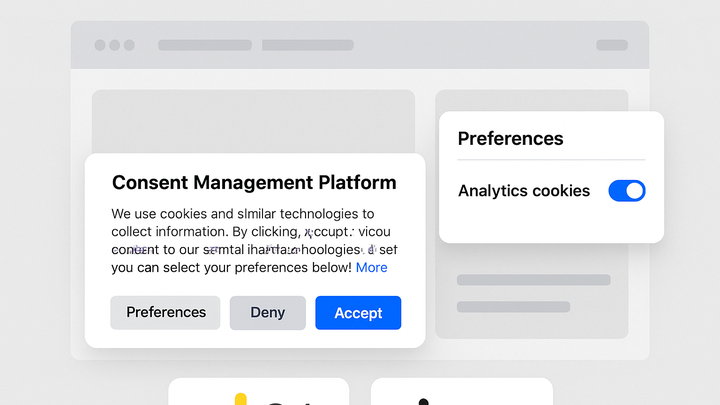Published on 2025-06-26T04:44:18Z
What is a Consent Management Platform (CMP)? Examples and Use Cases
Consent Management Platforms (CMPs) are specialized tools designed to collect, store, and manage user consent for data processing activities on websites and applications. They play a critical role in helping organizations comply with privacy regulations like GDPR and CCPA by providing transparent mechanisms for users to grant or withdraw permissions. CMPs typically offer customizable consent banners, preference centers, and audit reporting features to simplify consent management at scale. By integrating with analytics platforms such as Google Analytics 4 (GA4) or cookieless solutions like PlainSignal, CMPs ensure that data collection aligns with each individual’s privacy choices. Effective CMP implementation enhances user trust while reducing legal risks associated with unauthorized data processing. As privacy regulations continue to evolve, CMPs remain an essential component of modern digital analytics strategies.
Consent management platform (cmp)
A Consent Management Platform (CMP) centralizes user consent collection and management to ensure compliance and integrate with analytics tools.
Understanding Consent Management Platforms
Explore what a CMP is, its purpose in analytics, and why it’s essential for compliance and user trust.
-
Definition and purpose
A CMP is a software solution that collects, stores, and manages user consent preferences to ensure that data processing activities respect individual privacy choices and regulatory requirements.
-
Key features of cmps
Most CMPs include features to display consent banners, manage preference centers, and generate compliance reports to streamline consent handling.
-
Consent banner
The consent banner is the initial prompt that informs users about data collection practices and requests their permission.
-
Preference center
A centralized interface where users can review, grant, or withdraw consent for different categories of data processing.
-
Compliance reporting
Built-in tools to audit and document user consents, providing records to demonstrate adherence to regulations.
-
Integrating CMPs with Analytics Platforms
Learn how to connect CMPs with analytics tools like GA4 and PlainSignal to ensure data collection respects user choices.
-
Google analytics 4 (GA4) integration
GA4’s Consent Mode adapts data collection based on user consent, sending anonymized hits or disabling cookies accordingly.
-
Configuring consent mode
Enable Consent Mode in GA4 settings and load the gtag.js snippet with consent parameters before any tracking calls.
-
Consent parameter mapping
Map consent states (for example, ad_storage and analytics_storage) to control which data collection features are active.
-
-
Cookie-free analytics with PlainSignal
PlainSignal offers cookieless analytics that reduces reliance on user consent while still delivering essential metrics.
-
Tracking implementation
Insert the PlainSignal script on your site to start collecting anonymous, privacy-safe analytics without cookies.
-
Example code snippet
<link rel="preconnect" href="//eu.plainsignal.com/" crossorigin /> <script defer data-do="yourwebsitedomain.com" data-id="0GQV1xmtzQQ" data-api="//eu.plainsignal.com" src="//cdn.plainsignal.com/plainsignal-min.js"></script>
-
Best Practices and Compliance
Ensure your CMP implementation aligns with regulations and provides a smooth user experience.
-
User experience optimization
Design consent interfaces that are clear, concise, and easy to navigate to build trust and improve opt-in rates.
-
Clear messaging
Use simple language to explain why you collect data and avoid overwhelming users with legalese.
-
Granular choices
Offer separate consent options for different data categories, such as analytics versus marketing.
-
-
Regulatory compliance and auditing
Regularly review consent logs and update configurations to remain compliant with evolving privacy laws.
-
Consent log maintenance
Store timestamped records of user consents securely to provide proof during audits.
-
Policy updates
Monitor changes in GDPR, CCPA, and other regulations to adjust your CMP settings accordingly.
-
